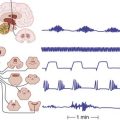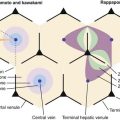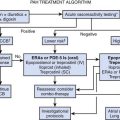Chapter 89 Acute Abdomen
Anatomic and Physiologic Considerations
The Peritoneum
The peritoneum provides a protective environment for the intra-abdominal organs, and, because of its marked sensitivity, a valuable “window” for the examining health care provider. It is composed of a single layer of mesothelial cells lining the abdominal cavity along the abdominal wall (the parietal peritoneum) and the intra-abdominal viscera (the visceral peritoneum). The space between these is the peritoneal cavity. Beneath the mesothelium is a submesothelial layer of extracellular matrix, capillaries, and lymphatics.1 The peritoneum’s sensitivity to inflammation, ischemia, and necrosis is mediated by the fluid in the peritoneum that contains macrophages and other leukocytes.2 Thus, with a focus of inflammation anywhere in the peritoneal cavity, inflammatory mediators are released by these leukocytes, often resulting initially in poorly localized, generalized pain. With irritation of the peritoneum associated with early appendicitis, for example, the patient interprets the inflammation as periumbilical pain. This is related to the embryologic development along dermatomes. As more inflammatory cytokines are secreted throughout the peritoneal cavity, the pain becomes more generalized and will eventually result in spasm of the overlying muscles of the abdominal wall, interpreted by the examiner as guarding.
Visceral Blood Flow
The regulation of visceral blood flow is a tightly controlled balance of neural, humoral, paracrine, and metabolic factors.3 In the gut, enteral feeding increases the blood flow and the metabolic demands on the intestinal mucosa. Some of these effects are directly related to the nutrients in the intestinal lumen, whereas others are dependent on the enteric nervous system and the associated refexes, on gastrointestinal hormones, and on gastrointestinal vasoactive mediators such as adenosine, endothelin-1, and nitric oxide.4 In pathologic states such as sepsis alone or shock, whether from sepsis, hemorrhage, or cardiac failure, visceral blood flow is reduced, which can lead to ischemia of the intestinal mucosa and submuscosa. Even with restoration of blood pressure and cardiac output after treatment of shock, microvascular perfusion of the intestine may remain impaired resulting in mucosal ischemia and persistent lactate production.
Such ischemia can lead to altered integrity of the mucosal barriers to bacteria and other pathogens, thus increasing the entry of endotoxins into the splanchnic venous and lymphatic systems. These pathogens can fuel the inflammatory response. This finding has fostered the theory of “the gut as a central organ of sepsis or multisystem organ failure.”5 Whether the translocation of bacteria or endotoxin from gut lumen to splanchnic drainage is the chicken or egg can be debated; regardless, this perturbation of intestinal blood flow contributes to the pathophysiology of shock and sepsis.
Other conditions in the ICU can affect splanchnic blood flow, especially mechanical ventilation with high inspiratory pressures, high positive end-expiratory pressure, or high tidal volumes.6,7
Laboratory Tests
Amylase is a valuable diagnostic test for children with abdominal pain or unexplained intra-abdominal sepsis as hyperamylasemia can indicate pancreatitis. Elevated amylase is not specific to pancreatic insults and can be elevated with head trauma, decreased renal clearance, and intestinal obstruction. Serum lipase can be an additive test to the assessment of the pancreas. It tends to be more specific to the pancreas, but can be mildly elevated in intestinal obstruction as well. When both amylase and lipase are markedly elevated, pancreatitis is most likely. Children with a history of severe or chronic pancreatitis might not have marked elevations, so the level of the enzyme does not always correlate with the severity of the disease.
Imaging Options
Ultrasonography
Ultrasonography has several advantages over other imaging studies, most notably its portability, which obviates the need for moving the patient and its lack of ionizing radiation exposure. In addition, the use of Doppler modality permits assessment of visceral blood flow to kidneys, pelvic organs, and the gastrointestinal tract. When the relative positions of the mesenteric vein and artery can be accurately determined, an abnormal orientation suggests an increased risk of malrotation, even without midgut volvulus.9 The presence of a “whirlpool sign” can be diagnostic of malrotation with midgut volvulus.10 Neither finding is sensitive enough to exclude the diagnosis of malrotation. Thus, if suspected, malrotation requires an upper gastrointestinal contrast study to assess the position of the duodenal-jejunal junction.11 Assessment of gall bladder wall thickening suggestive of acalculous cholecystitis or biliary tree dilation are particularly accurate. Intra-abdominal and pelvic fluid collections can be identified and characterized well with ultrasonography, suggesting collections that would be suitable for drainage, either surgical or percutaneous, via ultrasound guidance. In the patient with bowel obstruction or severe paralytic ileus, the resultant intestinal distention creates ultrasonic distortion, minimizing the value of this imaging modality.
Computed Tomography
Abdominal computed tomography (CT) scans are accurate, fairly rapid, and can be used to guide interventional procedures such as percutaneous biopsies or drainage of intra-abdominal fluid collections. Except in institutions where CT scans are located in the ICU or those that have mobile CT units, patients must be transported to access imaging with this modality. That requirement can be a significant challenge with children who are ventilated or hemodynamically unstable. In addition to the transport challenges, the radiation exposure of a CT scan may pose a risk for developing malignancies later in life, especially for those children who receive serial radiographs.12 That risk can be reduced by using directed scans (i.e., limiting the scan to the portion of the abdomen in question). Other risks include the administration of intravenous contrast material that can cause anaphylaxis in those who are allergic, or renal injury, especially in those who might already be hypovolemic or receiving nephrotoxic drugs.13 That risk can be minimized as well, by using nonionic contrast materials, or with the administration of sodium bicarbonate and N-acetylcysteine before the administration of the intravenous contrast. Administration of enteral contrast can result in aspiration if there is intestinal obstruction or delayed gastric emptying with vomiting or gastroesophageal reflux.
Magnetic Resonance Imaging
Magnetic resonance imaging (MRI) of the abdomen can be valuable, especially because the risks of radiation can be obviated, but the logistical challenges of moving an ICU patient to the MRI suite are similar to those mentioned previously for CT scans. The added challenges posed by MRI include the slower speed of the image capture that interferes with accessing the unstable patient for interventions, as well as the restrictions for certain MRI-incompatible ICU equipment to be in the MRI scanning room. Despite this, MRI enterography and cholangiography are now capable of generating very revealing images of the gastrointestinal and hepatobiliary tracts.14 Thus, if the value of the images can offset the risks of transporting a sick child to the MRI suite, it should be considered.
Abdominal Conditions Requiring Intensive Care Unit Care
Perforated Viscera
Children with perforation of the gastrointestinal tract will frequently require either preoperative resuscitation or postoperative stabilization in the ICU. The most common condition resulting in perforation is appendicitis. Although perforated appendicitis is common, occurring in 30% to 50% of children who present to children’s hospitals with appendicitis,15 it is unusual for it to result in serious intra-abdominal sepsis. Nevertheless, deaths do still occur in such children, related most often to septic shock with cardiovascular collapse or severe acute respiratory distress syndrome.
Ingested foreign bodies can lead to perforation anywhere in the gastrointestinal tract, with common items being sharp materials such as pins or nails, fish bones, disc batteries, and magnets.16 Trauma can also result in perforation, notably in lap seat belt injuries from motor vehicle accidents, or in cases of nonaccidental trauma where a punch or kick can compress the small bowel against the vertebral column causing a jejunal perforation. Therefore, characteristic in this mechanism is that the intraoperative finding of a jejunal perforation in the absence of a known trauma history should prompt an evaluation by the hospital’s child abuse team.17
Neutropenic Enterocolitis
Children who have significant neutropenia, whether drug-induced from chemotherapy for malignant diseases or as a primary disease, may develop inflammation of the intestinal tract. The most common location is the right colon. Historically, this has been termed typhlitis, but more accurately is labeled neutropenic enterocolitis, because it can affect other portions of the intestinal tract as well. It may be preceded by mucositis that permits the intestinal bacteria to invade the bowel wall. Affected children exhibit fever, abdominal pain and tenderness, abdominal distention, ileus or diarrhea, radiographic signs of inflammation, and sometimes hemodynamic instability. The diagnosis is made best by CT scan or ultrasound.18 Surgical treatment is reserved for those patients with peritonitis or hemodynamic instability after appropriate resuscitation.
Hemorrhage
The liver is also a commonly injured organ in blunt abdominal trauma, and it too can usually be managed nonoperatively. The development of hemobilia several weeks after nonoperative management of hepatic laceration is uncommon, but when it occurs it can result in significant gastrointestinal bleeding. This can usually be managed with arteriographic embolization or endoscopic biliary stent placement,19 but sometimes requires resection of the involved hepatic segment or lobe.
Other Specific Conditions
Abdominal Compartment Syndrome
Intra-abdominal hypertension (IAH) is defined as intra-abdominal pressure (IAP) that is >12 mm Hg. Although this is relatively uncommon in pediatric ICU patients, it can be associated with a high morbidity and mortality. If the IAP reaches a point where perfusion to intra-abdominal organs is compromised, a constellation of organ dysfunctions may occur including renal insufficiency, intestinal ischemia, hepatic dysfunction, elevated diaphragms, and respiratory insufficiency.20–22 This constellation is termed abdominal compartment syndrome (ACS). Risk factors for ACS include massive fluid resuscitation for any illness, intra-abdominal hemorrhage, intra-abdominal inflammation or infection from any cause, obesity, and tight abdominal wall closures following laparotomy. As with compartment syndrome in extremities, there is no absolute pressure to define the presence of ACS; the intravascular volume status, blood pressure, and systemic vascular resistance are all factors that can impact the perfusion pressure of the abdominal organs and minimize the effect of the IAP. An abdominal perfusion pressure can be calculated as the mean arterial pressure minus the IAP. If abdominal perfusion pressure is > 60 mm Hg, a higher survival rate has been reported. The diagnosis of ACS is made when there is a sustained increased IAP in combination with signs of organ dysfunction such as decreased cardiac output, oliguria, and respiratory insufficiency. Other organ systems that can be affected by IAH include the reduction of portal and mesenteric venous flow, potentially leading to hepatic dysfunction and intestinal edema and ischemia. In addition, the increased intrathoracic pressure that can result from the elevated diaphragms can raise intracranial pressure.
If the diagnosis of ACS is suspected, efforts to augment perfusion must be initiated. Avoid the reverse Trendelenburg or prone positions because these can increase IAP. Effective decompression of the gastrointestinal tract is important and can be optimized by effective nasogastric tube drainage, administration of prokinetic medications, and colonic decompression by either enemas or colonoscopy. Supporting renal function is also important and includes liberal use of diuretics along with volume resuscitation. If these maneuvers have not improved the organ function, temporary decompression by insertion of an abdominal drain to decrease the amount of fluid in the abdomen may be necessary. If this does not adequately decompress the IAH, laparotomy is necessary with placement of a sterile patch or silo that may provide sufficient compliance to reverse the ACS.
1. Cheong Y.C., Laird S.M., Li T.C., et al. Peritoneal healing and adhesion formation/reformation. Hum Reprod Update. 2001;7:556-566.
2. Holmdahl L., Ivarsson M.L. The role of cytokines, coagulation, and fibrinolysis in peritoneal tissue repair. Eur J Surg. 1999;165:1012-1019.
3. Matheson P.J., Wilson M.A., Garrison R.N. Regulation of intestinal blood flow. J Surg Res. 2000;93:182-196.
4. Zakaria E.R., Li N., Garrison R.N. Mechanisms of direct peritoneal resuscitation-mediated splanchnic hyperperfusion following hemorrhagic shock. Shock. 2007;27:436-442.
5. Mainous M.R., Ertel W., Chaudry I.H., Deitch E.A. The gut: a cytokine-generating organ in systemic inflammation. Shock. 1995;4:193-199.
6. Jakob S.M. The effects of mechanical ventilation on hepato-splanchnic perfusion. Curr Opin Crit Care. 2010. Epub ahead of print
7. Putensen C., Wrigge H., Hering R. The effects of mechanical ventilation on the gut and abdomen. Curr Opin Crit Care. 2006;12:160-165.
8. Evennett N.J., Petrov M.S., Mittal A., Windsor J.A. Systematic review and pooled estimates for the diagnostic accuracy of serological markers for intestinal ischemia. World J Surg. 2009;33:1374-1383.
9. Weinberger E., Winters W.D., Liddell R., et al. Sonographic diagnosis of intestinal malrotation in infants: importance of the relative positions of the superior mesenteric artery and vein. AJR. 1992;159:825-828.
10. Pracros J.P., Sann L., Genin G., et al. Ultrasound diagnosis of midgut volvulus: the ‘whirlpool’ sign. Pediatr Radiol. 1998;22:18-20.
11. Lampl B., Levin T.L., Berdon W.E., Cowles R.A. Malrotation and midgut volvulus: a historical review and current controversies in diagnosis and management. Pediatr Radiol. 2009;39:359-366.
12. Rice H.E., Frush D.P., Farmer D., Waldhausen J.H. Review of radiation risks from computed tomography: essentials for the pediatric surgeon. J Pediatr Surg. 2007;42:603-607.
13. Patzer L. Nephrotoxicity as a cause of acute kidney injury in children. Pediatr Nephrol. 2008;23:2159-2173.
14. Schaefer J.F., Kirschner H.J., Lichy M., et al. Highly resolved free-breathing magnetic resonance cholangiopancreatography in the diagnostic workup of pancreaticobiliary diseases in infants and young children—initial experiences. J Pediatr Surg. 2006;41:1645-1651.
15. Nelson D.S., Batemen B., Bolte R.G. Appendiceal perforation in children diagnosed in a pediatric emergency department. Pediatr Emerg Care. 2000;16:233-237.
16. Shah S.K., Tieu K.K., Tsao K. Intestinal complications of magnet ingestion in children from the pediatric surgery perspective. Eur J Pediatr Surg. 2009;19:334-337.
17. Barnes P.M., Norton C.M., Dunstan F.D., et al. Abdominal injury due to child abuse. Lancet. 2005;366:187-188.
18. McCarville M.B., Adelman C.S., Li C., et al. Typhlitis in childhood cancer. Cancer. 2005;104:380-387.
19. Singh V. Endoscopic management of traumatic hemobilia. J Trauma. 2007;62:1045-1047.
20. Malbrain M., Cheatham M., Kirkpatrick A., et al. Results from the international conference of experts on intra-abdominal hypertension and abdominal compartment syndrome. I. Definitions. Intensive Care Med. 2006;32:1722-1732.
21. Carlotti A.P.C.P., Carvalho W.B. Abdominal compartment syndrome: a review. Pediatr Crit Care Med. 2009;10:115-120.
22. Cheatham M., Malbrain M., Kirkpatrick A., et al. Results from the international conference of experts on intra-abdominal hypertension and abdominal compartment syndrome. II. Recommendations. Intensive Care Med. 2007;33:951-962.





